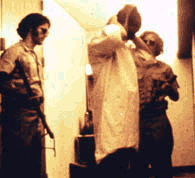 |
 |
 |
 |
The prisoner was then issued a uniform. The main part of this uniform was a dress, or smock, which each prisoner wore at all times with no underclothes. On the smock, in front and in back, was his prison ID number.  On each prisoner's right ankle was a heavy chain, bolted on and worn at all times. Rubber sandals were the footware, and each prisoner covered his hair with a stocking cap made from a woman's nylon stocking. On each prisoner's right ankle was a heavy chain, bolted on and worn at all times. Rubber sandals were the footware, and each prisoner covered his hair with a stocking cap made from a woman's nylon stocking.
It should be clear that we were trying to create a functional simulation of a prison -- not a literal prison. Real male prisoners don't wear dresses, but real male prisoners do feel humiliated and do feel emasculated. Our goal was to produce similar effects quickly by putting men in a dress without any underclothes. Indeed, as soon as some of our prisoners were put in these uniforms they began to walk and to sit differently, and to hold themselves differently -- more like a woman than like a man.
The chain on their foot, which also is uncommon in most prisons, was used in order to remind prisoners of the oppressiveness of their environment. Even when prisoners were asleep, they could not escape the atmosphere of oppression. When a prisoner turned over, the chain would hit his other foot, waking him up and reminding him that he was still in prison, unable to escape even in his dreams.

|
 |



 |
|
 |
 |
 |







